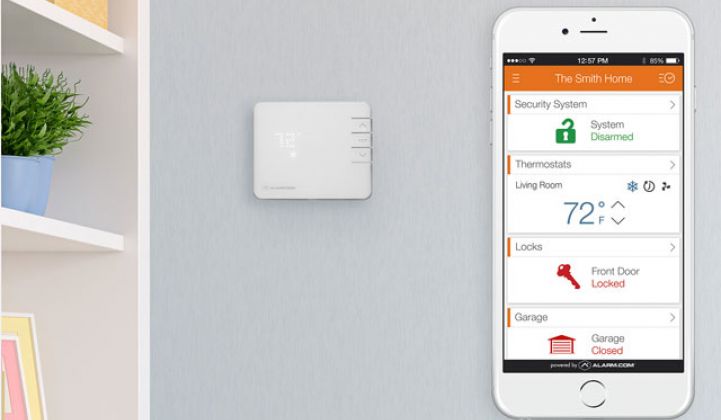There is no shortage of intelligent digital thermostats on the market today.
But security company Alarm.com didn’t feel that any available products integrated with its own security offering in exactly the way it wanted. So the company recently launched its own thermostat to provide another option to its network of dealers.
“We really asked, ‘How do we take smart-home-as-a-service and integrate a device that can take advantage of the rest of the platform?'” said Jay Kenny, senior VP of marketing with Alarm.com.
Alarm.com is primarily in the software business, not the hardware business. But it does build its own hardware on occasion, such as radio modules that integrate into other devices to work with Alarm.com’s platform. Thermostats are the number-one smart home device being sold after security devices.
Many smart thermostats operate using Wi-Fi, but Alarm.com's device uses cellular communication. Integration with smart thermostats on its platform uses Z-Wave, which limits the number of thermostats that are available to Alarm.com customers. Although the company was happy with many of the smart thermostats it offers through its dealer, the company also felt it could offer a more seamless experience by designing its own device.
“As we move beyond security, we felt we have a better experience if [the thermostat] is integrated across a home,” said Kenny.
The thermostat was designed to be sleek, yet timeless, given the long lifespan of most thermostats, he added, and with a focus on putting the intelligence into the cloud (and not the device) to keep the price relatively low. It sells to dealers for $149, substantially lower than similar offerings from ecobee and Nest, which cost about $250.
The thermostat has access to every sensor in a home’s security system, allowing it greater insight into who is home and which rooms are being used. Furthermore, it can adjust the necessary settings if a door or window is left open.
Like many other thermostats, the device also has geo-fencing capabilities, so it can sense when residents with smartphones approach and leave the home. Geo-fencing can also be set for other places, such as a workplace, so the device knows when you’re leaving the office.
In one way, the thermostat seems to take on Nest, which uses its thermostat as the hub for a smart home. Other Nest products, such as the smoke alarm, connect back to the thermostat. Alarm.com’s thermostat can also connect to a smoke detector and automatically shut off the HVAC system so that smoke is not recirculated through the home.
Other thermostats, such as ecobee's device, have also been offering more sensors to go with the thermostat to provide greater precision in heating and cooling. Alarm.com’s thermostat will also offer additional temperature sensors that can be placed anywhere in the home to get a more accurate read of temperatures across the home.
The competition and innovation in the smart-thermostat space is good for consumers, who can choose a thermostat based on which features appeal to them the most, and also because the increased sensoring will likely only drive down heating and cooling needs for homes that use the technology. By the end of this year, smart thermostats will start to make up the majority of all thermostat sales in the U.S., according to Parks Associates.
For Alarm.com, having its own thermostat will also help the company expand into more commercial businesses, a priority for the firm, which went public earlier this summer. In its first earnings call earlier this month, Steve Trundle, CEO of Alarm.com, said the company is looking for more international expansion opportunities, especially in Latin America, Turkey, New Zealand, Australia and South Africa.
Alarm.com is also set to expand the channels in which it already operates. Currently, it has more than 5,000 dealers but is looking to add HVAC service providers and utilities to the network. Although some regulated utilities are wary of reaching too far into the home, many energy retailers will increasingly have to compete with energy platforms from solar companies and independent power producers like NRG that offer everything from solar to internet to energy management. Alarm.com already owns demand-response platform provider EnergyHub.
The company reported second-quarter revenue of nearly $52 million, a 23 percent increase from 2014. For the full year, non-GAAP adjusted income is expected to be $9.8 million to $10.3 million and total revenue is projected to be $138.9 million to $139.3 million.



